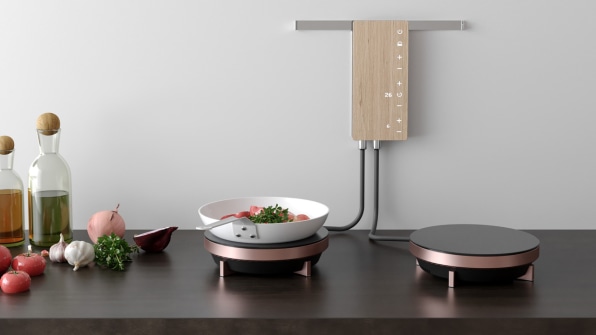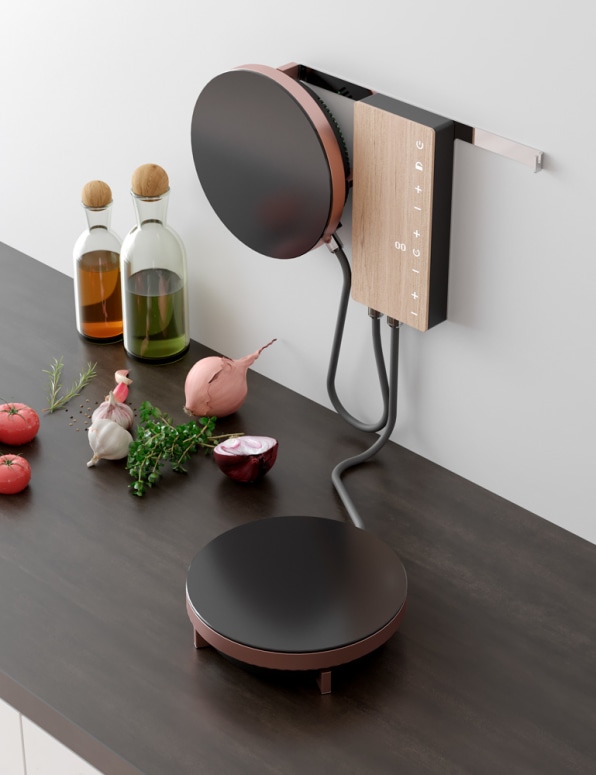It all comes down to heat delivery and insulation and this shows us how far we have progressed. something like this is safe now.
Freeing up counter space is also welcome as well. We still need the sink but a working counter that serves for cooking as well is helpful
Now then can we completely rework all counter top appliances so that they also can be stuck up on the wall as well? Blenders and toasters come immediately to mind, each with their individual power cord that goes with them.
Welcome to the future.
Why top restaurants are getting rid of stoves (and why you might, too)
These burners hang on your wall until you need to cook something, echoing a growing trend among professional kitchens.
[Photo: courtesy Adriano Design]
By Mark Wilson2 minute Read
https://www.fastcompany.com/90313508/why-top-restaurants-are-getting-rid-of-stoves-and-why-you-might-too
I once had the chance to peek my head into the kitchen at Alinea, the avant-garde Chicago restaurant that’s also one of the top-ranked in the world. It looked nothing like I expected. The standard elements of commercial kitchens, with their industrial griddles, stoves, and salamander broilers, were almost completely absent. Instead, it was just a long room filled with unadorned stainless steel tables. If a chef needed to sauté something, they simply grabbed an induction burner–a magnetic-based hotplate that generates no ambient heat–and brought it to their spot.
The flexible, spartan design of Alinea’s kitchen has stuck with me since. The French Laundry has since adopted a similar low-tech approach, and I’ve wondered if there would be any way to bring it into my own home.
Now, the Turin-based product design studio Adriano Design has developed a concept for the appliance manufacturer Fabita that feels like it could fundamentally help reimagine kitchen design in exactly this way.[Photo: courtesy Adriano Design]Dubbed Ordine, it’s a pair of induction burners ringed in copper, designed to look beautiful hanging on the wall. When it’s time to cook, you grab one, place it on the counter, and begin. It’s kind of like one of those magnetic knife blocks, but for a real appliance.
The improvisational nature of using Ordine is by design. “It gives the user the possibility of organizing the kitchen top space based on the necessities of any given moment, as well as the dimensions of the pots that one needs to use side-by-side,” write studio partners Davide and Gabriele Adriano over email. “[It’s] especially for small spaces or for those spaces–an office space, for example–where you’d want a cooking hub, but you wouldn’t dare to install one because it won’t fit in the context.”
[Photo: courtesy Adriano Design]A skeptic could point out that semi-portable induction burners have been popular for well over a decade. People can already design a kitchen with modular hot spots. (Alinea, after all, does just that. Crockpots and Instant Pots can be plopped anywhere in a kitchen, too.)
But the Ordine stands out for both its beauty and its user experience. It saves counter space when not in use, but still decorates your kitchen as a semi-ornamental range hood might. And since it’s already built into the wall where it draws power, you won’t find yourself cursing as you fish out a burner from under the sink, then negotiate a spaghetti tangle of cords to plug it in.
Fabita hired Adriano Design specifically to get people thinking about its core technologies differently, and to help Fabita launch its own line of appliances rather than merely manufacture them for other brands as it does today.
“Normally you would ask us about the type of induction technology inside, or how many watts are in its output,” the duo writes. “Instead we are here talking about the [UX] concepts! Yes, this is exactly what we want to talk about for creating a better future.”
The Ordino doesn’t exist as a product today, but it’s currently being developed for production in the second half of 2019, the designers tell me. Because as we all continue moving into tighter and tighter dwellings, the typical giant fridge, giant stove, and oven, and tiny counter setup just doesn’t make sense anymore.
About the author
Mark Wilson is a senior writer at Fast Company. He started Philanthroper.com, a simple way to give back every day
More


No comments:
Post a Comment